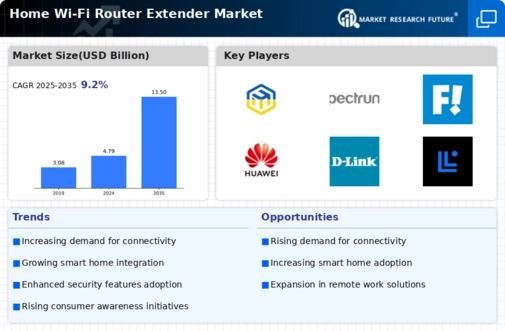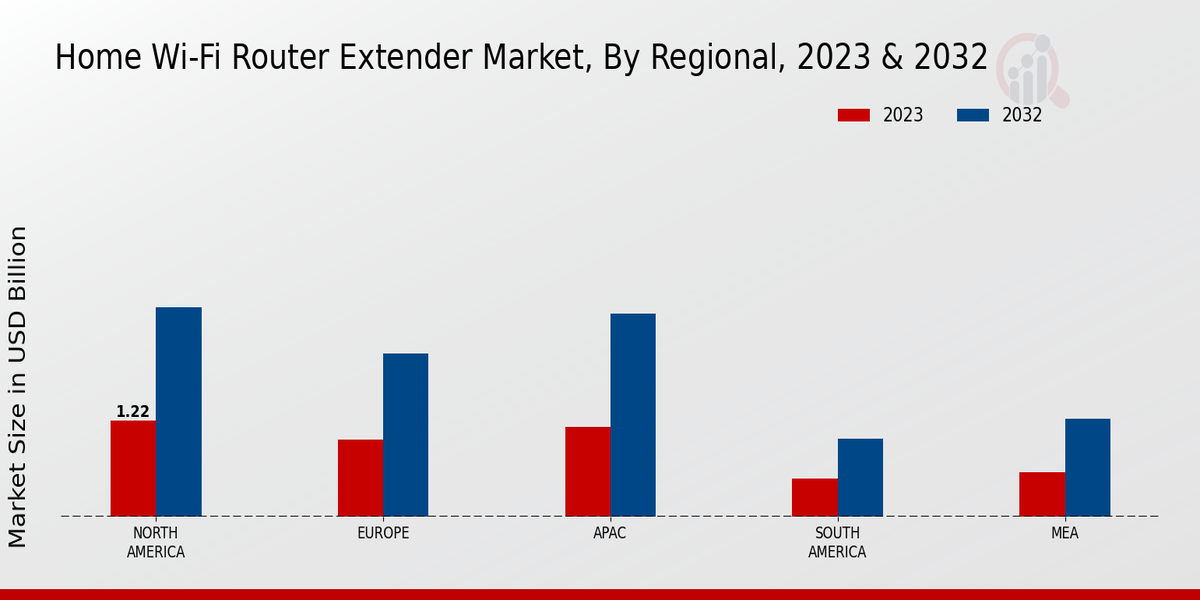Increased Internet Usage
The surge in internet usage across various demographics is a notable driver of the Global Home Wi-Fi Router Extender Market Industry. With more individuals engaging in online activities such as streaming, gaming, and telecommuting, the need for enhanced Wi-Fi coverage has become paramount. This trend is reflected in the projected market growth, with an expected CAGR of 9.85% from 2025 to 2035. As consumers seek solutions to improve their internet experience, Wi-Fi extenders are becoming essential tools for ensuring consistent connectivity, particularly in larger homes or spaces with challenging layouts.
Market Growth Projections
The Global Home Wi-Fi Router Extender Market Industry is poised for substantial growth, with projections indicating a market size of 4.79 USD Billion in 2024 and an anticipated increase to 13.5 USD Billion by 2035. This growth trajectory reflects a compound annual growth rate (CAGR) of 9.85% from 2025 to 2035. Such figures illustrate the expanding role of Wi-Fi extenders in enhancing home connectivity, driven by factors such as increased internet usage, the rise of smart home devices, and technological advancements. The market's evolution is indicative of a broader trend towards improved home networking solutions.
Rise of Smart Home Devices
The proliferation of smart home devices is substantially influencing the Global Home Wi-Fi Router Extender Market Industry. As consumers increasingly adopt smart technologies, including smart speakers, security cameras, and home automation systems, the demand for reliable Wi-Fi coverage becomes critical. These devices often require stable internet connections to function optimally, leading to a heightened need for Wi-Fi extenders. The market's growth trajectory suggests that the integration of smart home technologies will continue to drive demand for Wi-Fi extenders, as households seek to maintain connectivity across multiple devices simultaneously.
Rising Awareness of Network Security
The rising awareness of network security is increasingly driving the Global Home Wi-Fi Router Extender Market Industry. As cyber threats become more prevalent, consumers are becoming more conscious of securing their home networks. Wi-Fi extenders that offer enhanced security features, such as encryption and secure access protocols, are gaining traction among consumers. This heightened focus on security is likely to influence purchasing decisions, as individuals seek to protect their personal information and devices from potential breaches. Consequently, the demand for secure and reliable Wi-Fi extenders is expected to grow in tandem with consumer awareness of cybersecurity.
Growing Demand for High-Speed Internet
The increasing demand for high-speed internet connectivity is a primary driver of the Global Home Wi-Fi Router Extender Market Industry. As households become more reliant on multiple devices for streaming, gaming, and remote work, the need for robust Wi-Fi coverage has intensified. In 2024, the market is projected to reach 4.79 USD Billion, reflecting a significant shift in consumer behavior towards enhanced connectivity solutions. This trend is likely to continue, with projections indicating that by 2035, the market could expand to 13.5 USD Billion. Such growth underscores the necessity for effective Wi-Fi extenders to eliminate dead zones and ensure seamless internet access throughout homes.
Technological Advancements in Wi-Fi Technology
Technological advancements in Wi-Fi technology are significantly shaping the Global Home Wi-Fi Router Extender Market Industry. Innovations such as Wi-Fi 6 and mesh networking systems are enhancing the performance and efficiency of Wi-Fi extenders. These advancements allow for greater bandwidth, reduced latency, and improved coverage, making them more appealing to consumers. As technology continues to evolve, the demand for modern extenders that can support high-speed internet and multiple devices simultaneously is likely to increase. This trend indicates a shift towards more sophisticated solutions that cater to the growing needs of tech-savvy consumers.























Leave a Comment